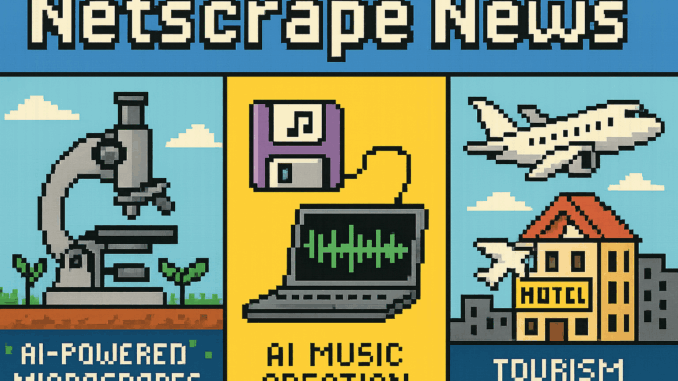
Remember the first time you peered through a school microscope, adjusting the focus wheel until pond water suddenly revealed a hidden universe of tiny creatures? Today’s AI technology news brings that same sense of discovery to farmyards, with an AI-Powered Microscope, while deepfake scams prove that seeing isn’t believing anymore.
Today’s Tech Roundup
AI-Powered Microscope Brings Lab-Grade Soil Analysis to Farms
MIT’s Agricultural Robotics Lab has developed a portable microscope system that combines classic 400x magnification optics with convolutional neural networks (machine learning algorithms that process visual data). The device analyzes soil samples in under 10 minutes, identifying microbial activity and nutrient levels with 95% accuracy compared to traditional lab tests.
Initial trials in Iowa cornfields showed 20% yield improvements through optimized soil management. Farmers receive instant recommendations for crop rotation or fertilizer use, replacing costly lab submissions that previously took weeks. The target price of £650 per unit makes this accessible to smaller operations.
It’s like watching a BBC Micro running sophisticated calculations on a farm – sometimes the best innovation comes from combining proven hardware with clever software, not reinventing everything from scratch.
UK Minister Admits “Financial Stretch” in Joining EU’s Starlink Rival
Science Minister Charlotte Atkins revealed the UK may not fund its €2.3 billion contribution to IRIS² – Europe’s encrypted satellite network designed to rival Starlink. The program requires 170 LEO satellites (low Earth orbit) for military and commercial use by 2028, offering quantum-key encrypted signals and 500Mbps user speeds.
UK participation would secure priority bandwidth for emergency services and rural broadband, but Treasury pushback threatens exclusion. Alternatives like partial funding or tech-sharing are now being negotiated, with a final decision deadline of 31 October 2025.
This echoes the 1990s satellite TV rollout debates – the same tension between public utility and cost that plagued early Sky Digital adoption. Sometimes the most important infrastructure decisions happen in budget meetings, not engineering labs.
“No Robot Rock Band?”: AI Music Challenges Creativity Norms
Anonymous AI band “Analog Dream” racks up significant Spotify streams (exact figure unverified) with algorithmically generated shoegaze tracks mimicking 1990s bands like Slowdive. The tracks were created using OpenAI’s MuseNet, trained on a large dataset of indie tracks (exact size unspecified), generating 30-second songs in under 5 seconds using transformer architectures (the same technology behind ChatGPT).
Meanwhile, platforms like Suno V3 allow users to create songs by inputting influences like “Radiohead meets Daft Punk.” Universal Music Group is leading IP lawsuits, while Bandcamp now offers a human-only streaming tier. Labels demand AI training opt-outs in artist contracts.
For anyone who remembers programming drum patterns on an Atari ST, you know the boundary between human creativity and machine assistance has always been blurrier than purists admit. This rekindles Napster-era debates about technology disrupting music, but with a twist – instead of copying existing songs, AI creates new ones that sound hauntingly familiar.
Malaysian Couple’s 370km Journey Ends at Non-Existent AI Cable Car
A Malaysian couple in their 70s travelled 230 miles from Kuala Lumpur to Penang after seeing a viral “sky cable car” video, only to discover the attraction didn’t exist. The video was created using Pika Labs’ AI video tool trained on Penang tourism footage, combining StyleGAN3 with video generation algorithms.
Investigators found 12 similar scams targeting Asian tourists this year, with losses exceeding £160,000. Authorities now require AI content watermarks in tourism ads, while ASEAN governments are reportedly considering digital consumer protection measures (status unconfirmed). The scam videos are detectable by metadata anomalies, but most consumers don’t know to check.
This recalls early internet hoaxes, but with tangible harm – like driving to a computer fair advertised in a dodgy magazine, only to find an empty car park. The difference is that today’s fakes are convincing enough to fool anyone without technical training.
From the Wayback Machine
On This Day: 1997 – Mars Pathfinder Lands on Mars
NASA’s Mars Pathfinder mission successfully landed in Mars’s Ares Vallis region, delivering the 264kg lander and 10.6kg Sojourner rover. The mission pioneered an innovative airbag landing system, bouncing 15 times before coming to rest and deploying its three “petals.” Sojourner, about the size of a microwave oven, exceeded its planned 7-day mission by operating for 83 days. The mission transmitted 2.3 billion bits of data and over 17,000 images, captivating global audiences through real-time web photo releases. Pathfinder’s low-cost, reliable approach set the template for future Mars missions and demonstrated the feasibility of mobile robotic exploration.
What This Means
Today’s AI technology news reveals a pattern of technology democratization hitting practical limits. AI microscopes make lab-grade analysis accessible to farmers, but budget constraints keep the UK from joining Europe’s satellite network. Meanwhile, AI-generated content becomes so convincing that it tricks real people into real journeys to fake destinations. The common thread is trust – whether in soil analysis, government funding priorities, or the authenticity of what we see online. As AI capabilities expand, the challenge isn’t just technical sophistication, but building systems people can rely on without becoming victims of their own gullibility.
Sometimes the most important question isn’t “can we build it?” but “should we trust it?” – and that’s a very human decision in an increasingly artificial world.

Leave a Reply